ASRock Rack E3C246D4I-2T Performance
For this exercise, we are using our legacy Linux-Bench scripts which help us see cross-platform “least common denominator” results we have been using for years as well as several results from our updated Linux-Bench2 scripts. At this point, our benchmarking sessions take days to run and we are generating well over a thousand data points. We are also running workloads for software companies that want to see how their software works on the latest hardware. As a result, this is a small sample of the data we are collecting and can share publicly. Our position is always that we are happy to provide some free data but we also have services to let companies run their own workloads in our lab, such as with our DemoEval service. What we do provide is an extremely controlled environment where we know every step is exactly the same and each run is done in a real-world data center, not a test bench.
We are going to show off a few results, and highlight a number of interesting data points in this article. You can always reference full reviews of each CPU to get more understanding on how they perform.
Python Linux 4.4.2 Kernel Compile Benchmark
This is one of the most requested benchmarks for STH over the past few years. The task was simple, we have a standard configuration file, the Linux 4.4.2 kernel from kernel.org, and make the standard auto-generated configuration utilizing every thread in the system. We are expressing results in terms of compiles per hour to make the results easier to read:
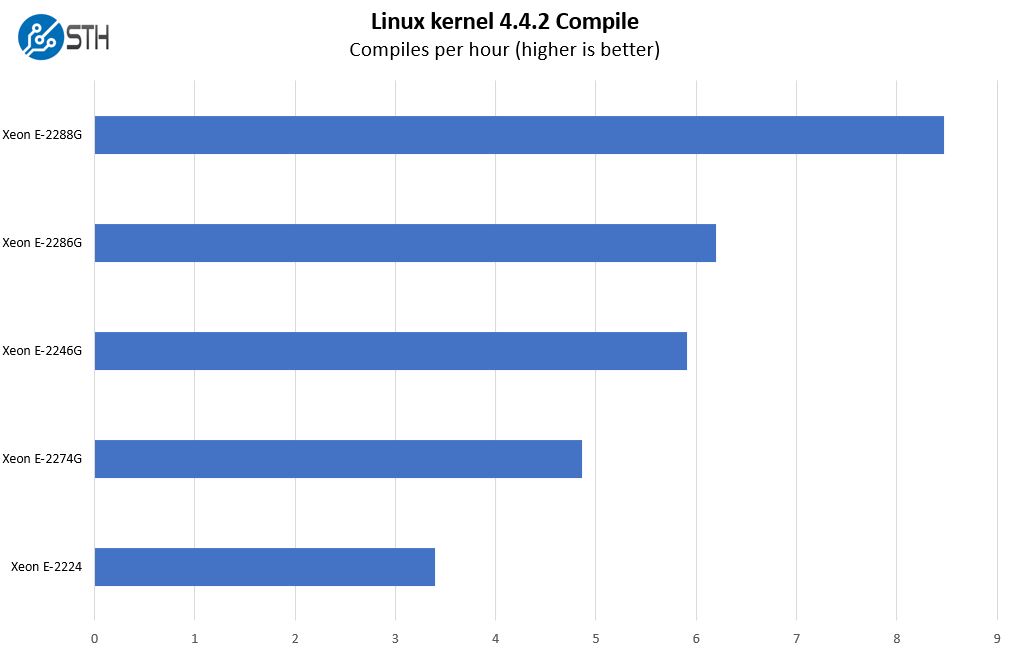
Here we can see a relatively large range in performance from top to bottom in the Intel Xeon E-2200 series SKUs.
c-ray 1.1 Performance
We have been using c-ray for our performance testing for years now. It is a ray tracing benchmark that is extremely popular to show differences in processors under multi-threaded workloads. We are going to use our 8K results which work well at this end of the performance spectrum.
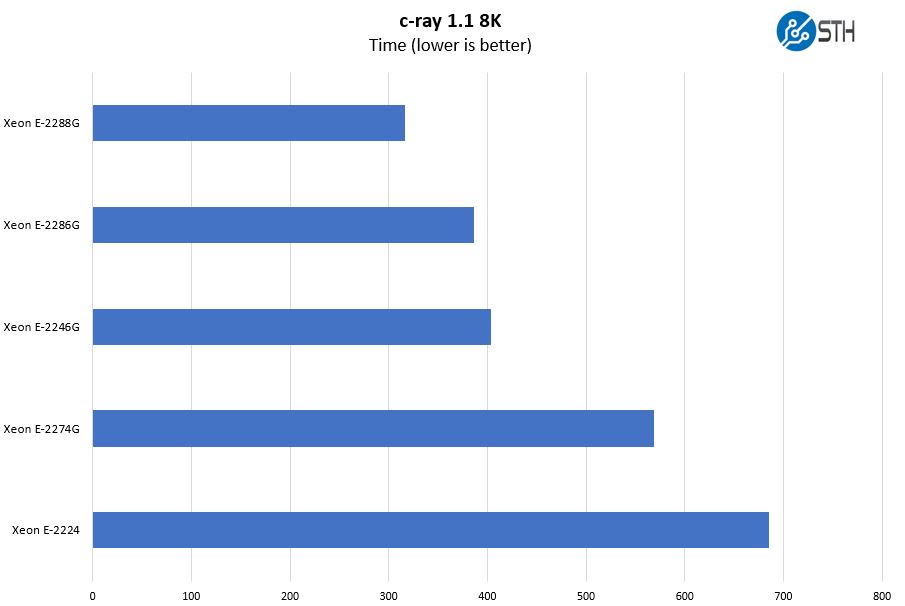
Something we did want to note is that ASRock Rack markets this as a Xeon E-2100 series platform. With more recent BIOS it can also accept the Xeon E-2200 series CPUs that we are testing here. Further, it can take many Coffee Lake-S CPUs, however, ECC memory support can be impaired based on the type of CPU used. That means one can use not just CPUs such as the Intel Core i3-9300, but there are others on the HCL as well such as the Intel Pentium Gold G5420.
7-zip Compression Performance
7-zip is a widely used compression/ decompression program that works cross-platform. We started using the program during our early days with Windows testing. It is now part of Linux-Bench.
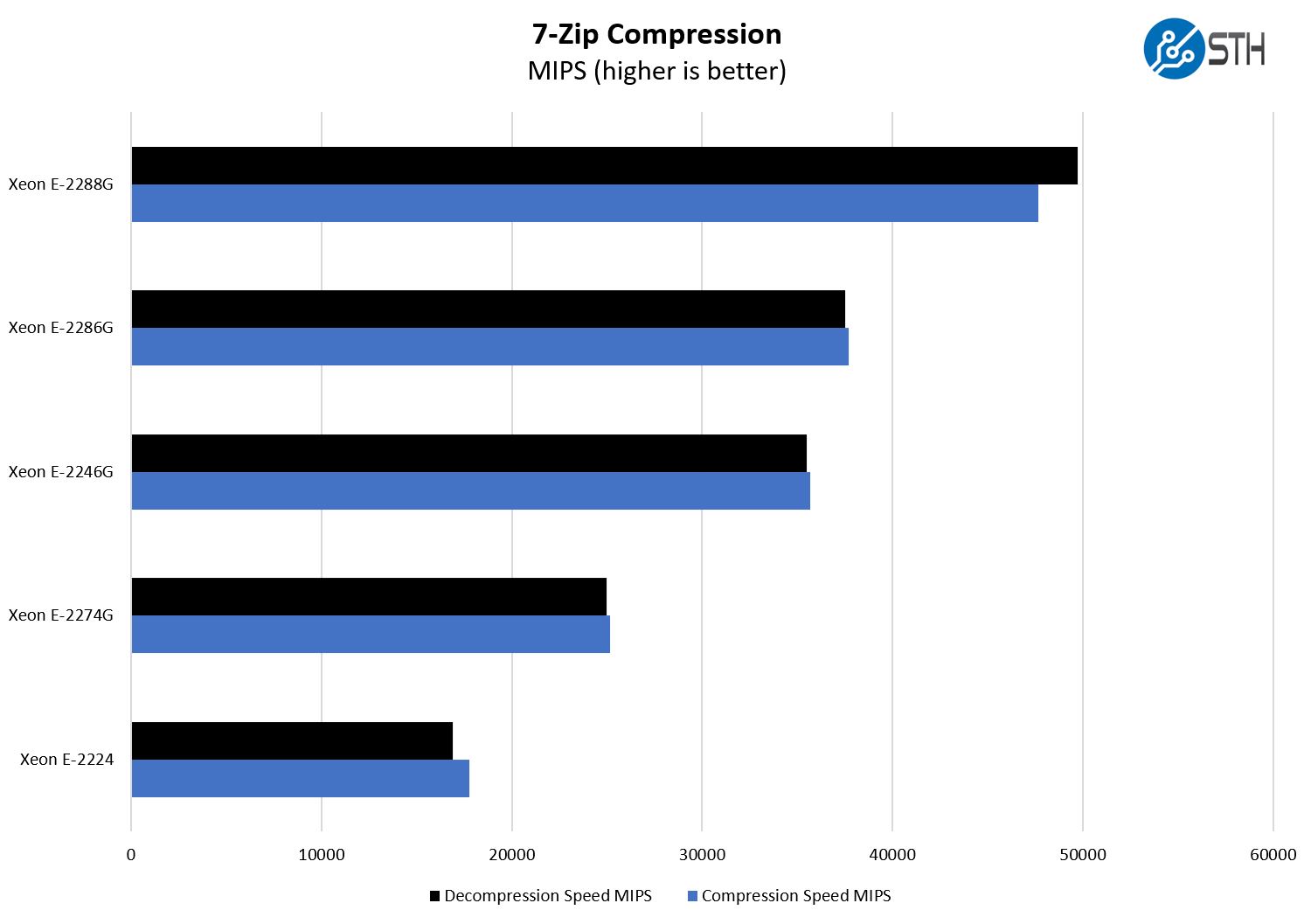
One can see the massive difference between the Xeon E-2286G and Xeon E-2288G here, that is simply due to supporting up to eight cores in this platform. The Xeon E-2274G is faster than the higher-end Xeon E3-1200 V6 CPUs just for some sense of scale here comparing to older systems that are getting near their replacement cycle.
OpenSSL Performance
OpenSSL is widely used to secure communications between servers. This is an important protocol in many server stacks. We first look at our sign tests:
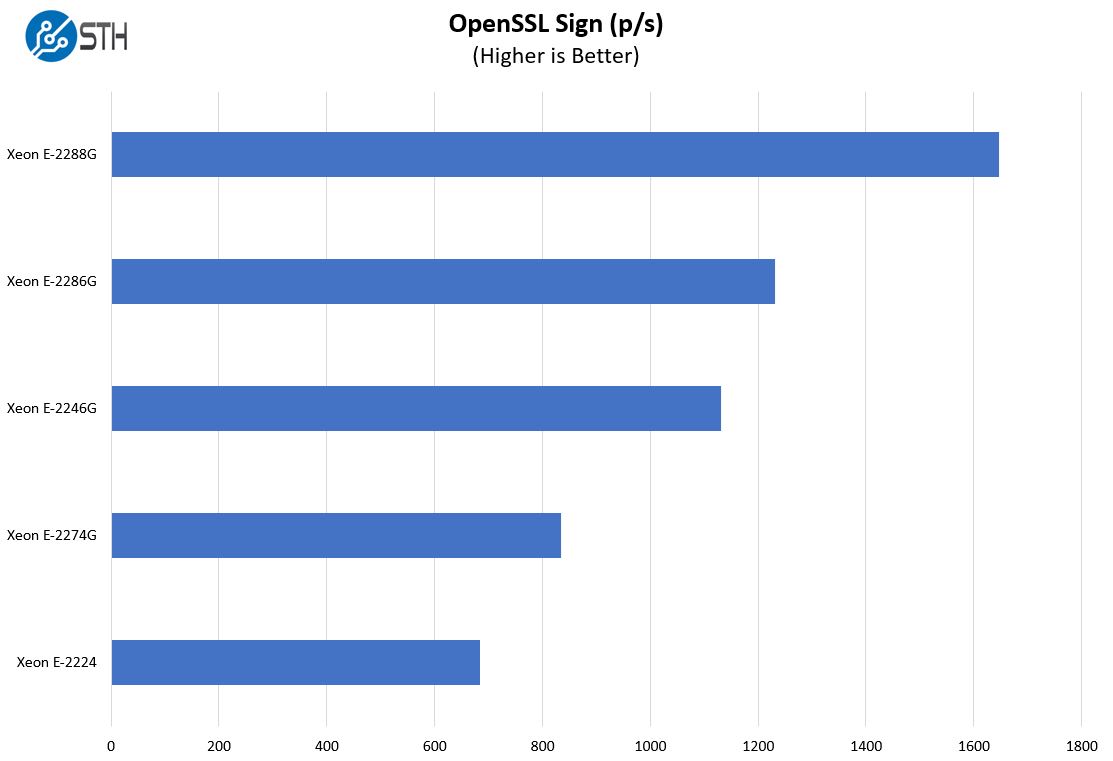
Here are the verify results:
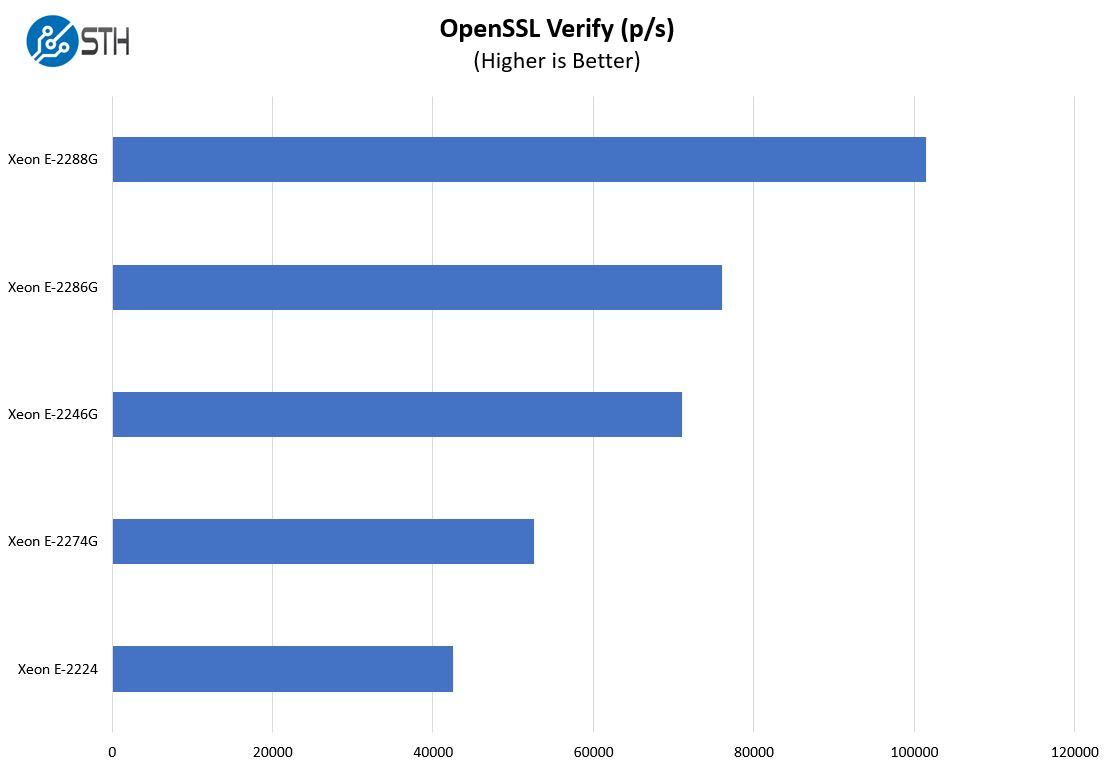
We also generally see much smaller jumps when there are the same numbers of cores/ threads in the system as we can see with the Intel Xeon E-2246G to Xeon E-2286G jump. Our advice is to primarily shop by core and thread counts.
Chess Benchmarking
Chess is an interesting use case since it has almost unlimited complexity. Over the years, we have received a number of requests to bring back chess benchmarking. We have been profiling systems and are ready to start sharing results:
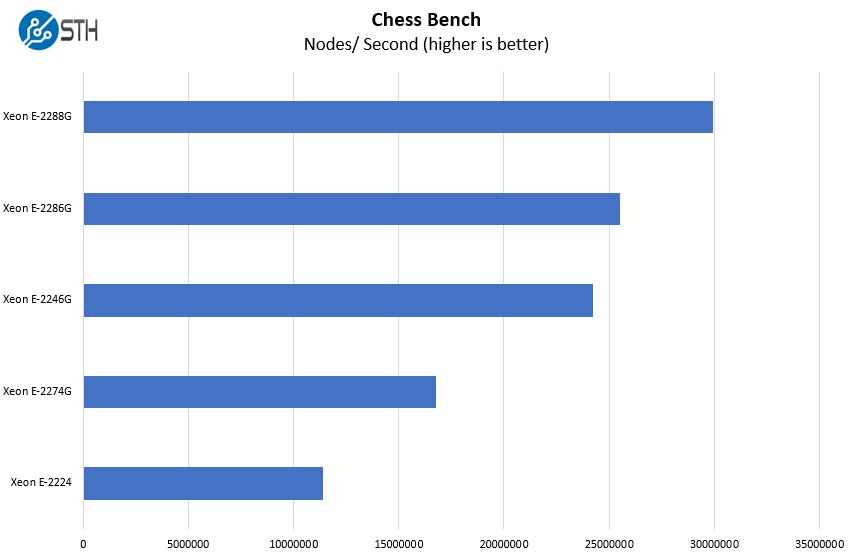
One intriguing option that we did not have time to test is that on the HCL we saw Intel Core “T” series CPUs with 35W TDPs. We commonly see these “T” parts in the ~1L systems we are testing as part of Project TinyMiniMicro. For newer ~1L nodes based on the 8th and 9th gen Core series, this can offer an interesting upgrade path to 10Gbase-T, more memory, and PCIe without having to purchase a new processor.
Next, we are going to get to our power consumption followed by market impact and our final words.




These boards are perfect for a vsan home lab. With dual 10gbe amazing. Get a microtik 10gbe switch and you are flying.
You could/could you get a 4x pcie to m.2 for the pcie slot and plug in your nvme storage.
At the end of the day all this adds up.
Does it support bifurcation x4x4x4x4 ? Can’t find it listed anywhere
@Casper
according to the datasheet for the Xeon E-2100 and E-2200 families, those CPUs do not support x4x4x4x4 bifurcation. Only x8x8 or x8x4x4 as per datasheet…
So AsRock made an Intel version of their X570D4I-2T? Striking similarities across the board. *hehe*
Was a bit surprised I didn’t see a mention of the review you did a while back.
@Kwirek – under the test configuration picture we mention this and why it is impactful.
@Dr. Manhatten
Did not think about looking in that data sheet, Thanks for clarification! :)
@Casper
i was just taking a look at the motherboard manual. I am not sure the board supports PCIe bifurcation at all, regardless of whether x8x8 or x8x4x4 (it is the job of the BIOS to set a bifurcation configuration based on CPU capability). The manual never mentions bifurcation once. While the BIOS has a parameter “PCIE Link Width”, this parameter remains largely unexplained. It might be related to PCIe bifurcation, or it might not. If in doubt, i would err on the side of caution and assume the board’s BIOS does not support bifurcation unless proven otherwise…
what cooler were you able to fit on it?
Too bad there isn’t a HDMI/video out from the CPU on the board as well.
Regarding bifurcation. I actually purchased this board (Assuming it didn’t bifurcate). The “PCIE Link With” option appears to be the bifurcation setting with x16, x8x8 or x8x4x4 options listed. Haven’t actually tested it yet however.
Looking for anyone else to corroborate a problem I’m seeing with this motherboard. Here is how to reproduce it:
1. Install any windows OS on a disk array utilizing the Onboard Intel Enterprise Software RAID
2. Make sure the ASPEED graphics drivers are installed
3. Initiate a RAID rebuild (pull one of the disks)
4. while the array is rebuilding, reboot the server
At this point, every system we test is going to a BSOD “DRIVER IRQL NOT LESS OR EQUAL”
If you uninstall the ASPEED graphics driver, the system will boot normally.
Here is a stupid question I must ask: I have the E3C256D4I-2T board which is identical just an upgrade. Do you plug in both the 4-pin to 24-pin and the 8-pin atx power or just the 4-pin to 24-pin adapter to power on. Is the 8-pin just reserved for DC-in only or does the board need extra power like a traditional board with the 8-pin attached. My problem is if I plug in the 8-pin along with the 4-24 adapter the board wont start. Its only with the 8-pin detached does it start….